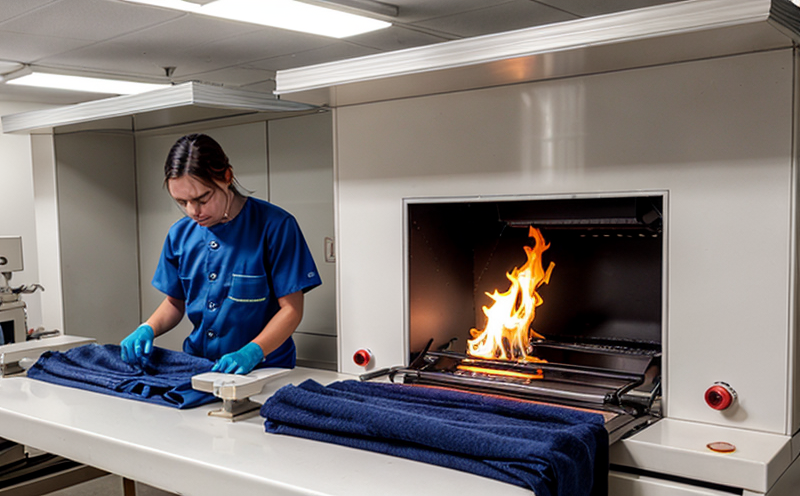Flammability Testing of Children's Sleepwear
The flammability testing of children’s sleepwear is a critical safety measure aimed at protecting infants and young children from potential hazards associated with fire. This service ensures that the textiles used in sleepwear meet stringent international standards, thereby safeguarding against the risk of ignition or flame spread. Compliance with these regulations is not only essential for product quality but also crucial for maintaining consumer trust and regulatory compliance.
The flammability testing process involves a series of rigorous tests designed to simulate real-world conditions under which children might come into contact with flames, such as from a candle, match, or flame on clothing. These tests are conducted using internationally recognized standards including ASTM F1675-19 and ISO 13933:2008. The focus is on identifying any materials that could pose a higher risk of ignition, ensuring that the sleepwear is safe for use by children.
The testing typically includes both pre-treatment and post-treatment assessments to account for any changes in flammability characteristics due to manufacturing processes like cutting, sewing, or finishing. Pre-treatment tests are conducted on unprocessed fabrics before they undergo production steps, ensuring that the raw materials themselves do not present a hazard. Post-treatment tests ensure that the final product remains safe after all manufacturing processes have been completed.
During testing, specimens from sleepwear samples are exposed to specific ignition sources under controlled conditions. The duration and intensity of these exposures vary depending on the type of fabric and its expected use. For instance, a cotton blend may be tested using different exposure times compared to polyester or a mix of both materials. After exposure, the specimens undergo detailed examination to determine their resistance to flame spread.
The results from these tests provide valuable insights into the flammability properties of children’s sleepwear. Compliance with established standards ensures that manufacturers can market their products safely and confidently across various markets. For quality managers and compliance officers responsible for ensuring product safety, this service offers peace of mind knowing that every batch meets rigorous safety criteria.
Flammability testing also plays a vital role in the research and development (R&D) process by enabling engineers to optimize materials and design without compromising on safety. By understanding how different fabrics behave under various conditions, R&D teams can innovate while staying within regulatory boundaries. This approach helps manufacturers stay ahead of evolving standards and consumer expectations.
Furthermore, this testing supports procurement efforts by identifying reliable suppliers who adhere strictly to quality standards. When sourcing materials for sleepwear, it is crucial to ensure that all components meet specific safety requirements. By working with trusted partners capable of providing compliant products through robust testing processes, organizations can maintain high levels of product integrity throughout their supply chains.
In summary, flammability testing serves multiple purposes—ensuring consumer safety, supporting compliance efforts, facilitating innovation in R&D, and enhancing procurement practices. It is a cornerstone of responsible manufacturing that prioritizes the well-being of children above all else.
Benefits
Ensures compliance with international standards like ASTM F1675-19 and ISO 13933:2008, guaranteeing product safety for children.
Reduces the risk of recall due to non-compliance or accidents involving fire hazards.
Enhances brand reputation by demonstrating commitment to child safety and quality assurance.
Supports continuous improvement in product design through detailed insights into material performance under various conditions.
Quality and Reliability Assurance
The service offers a robust framework for ensuring the highest levels of quality and reliability in children’s sleepwear. By adhering to stringent testing protocols, laboratories provide reliable data that can be used to make informed decisions about product safety. This commitment to excellence not only protects consumers but also fosters trust within the industry.
Quality assurance extends beyond mere compliance; it encompasses a holistic approach towards enhancing overall product performance. Through meticulous attention to detail during every stage of testing, laboratories strive to identify potential issues early on so that corrective actions can be taken promptly. This proactive stance ensures that any shortcomings are addressed before they reach the marketplace.
Reliability assurance is another key aspect of this service. By consistently delivering accurate and repeatable results, laboratories demonstrate their capability to maintain high standards over extended periods. This consistency builds confidence among clients who rely on these services for critical decision-making processes related to product safety.
International Acceptance and Recognition
The flammability testing of children’s sleepwear holds significant importance in gaining international acceptance and recognition. Compliance with recognized standards such as ASTM F1675-19 and ISO 13933:2008 ensures that products meet the requirements set by various regulatory bodies around the world.
Many countries have implemented strict regulations regarding flammability for children’s sleepwear, recognizing its potential impact on public health. By adhering to these guidelines, manufacturers can confidently export their products globally while meeting local safety standards. This international acceptance fosters broader market access and strengthens brand recognition in diverse markets.
The reputation gained from consistent adherence to high-quality testing processes also contributes significantly to global recognition. Laboratories that consistently deliver accurate results earn respect within the industry for providing reliable data that can influence policy decisions and best practices globally.





